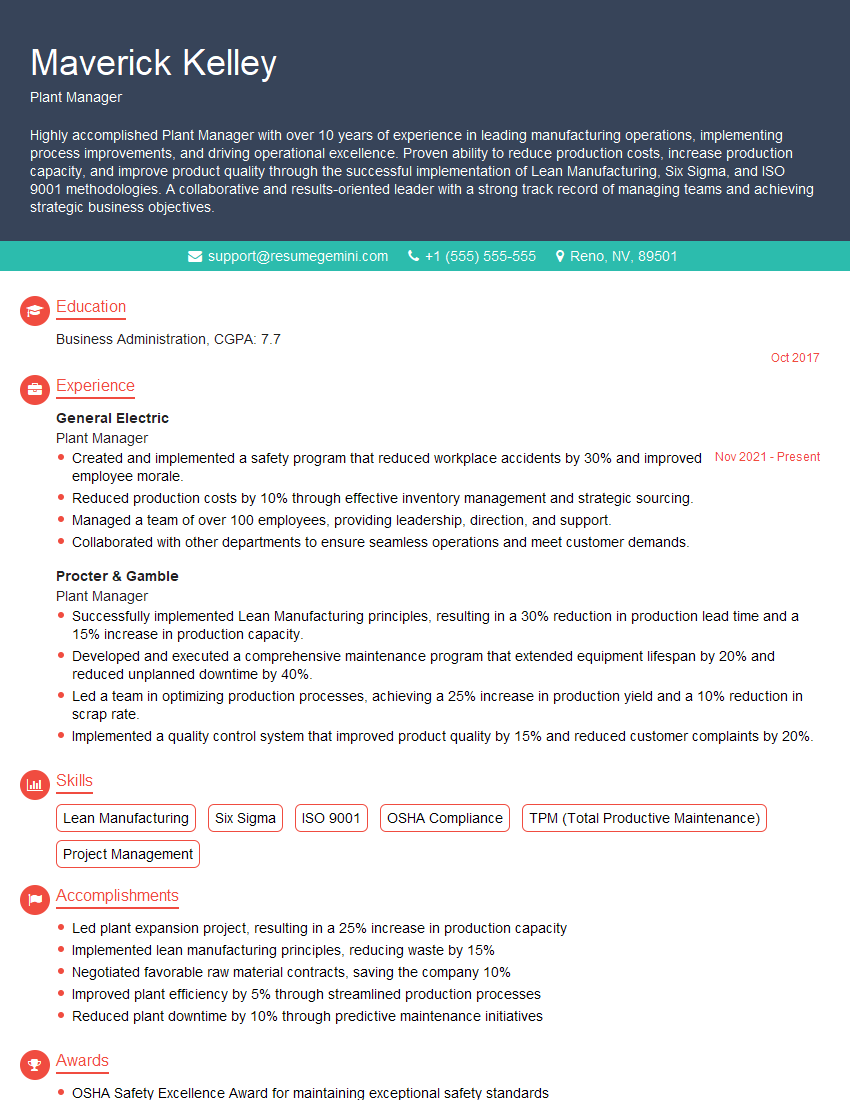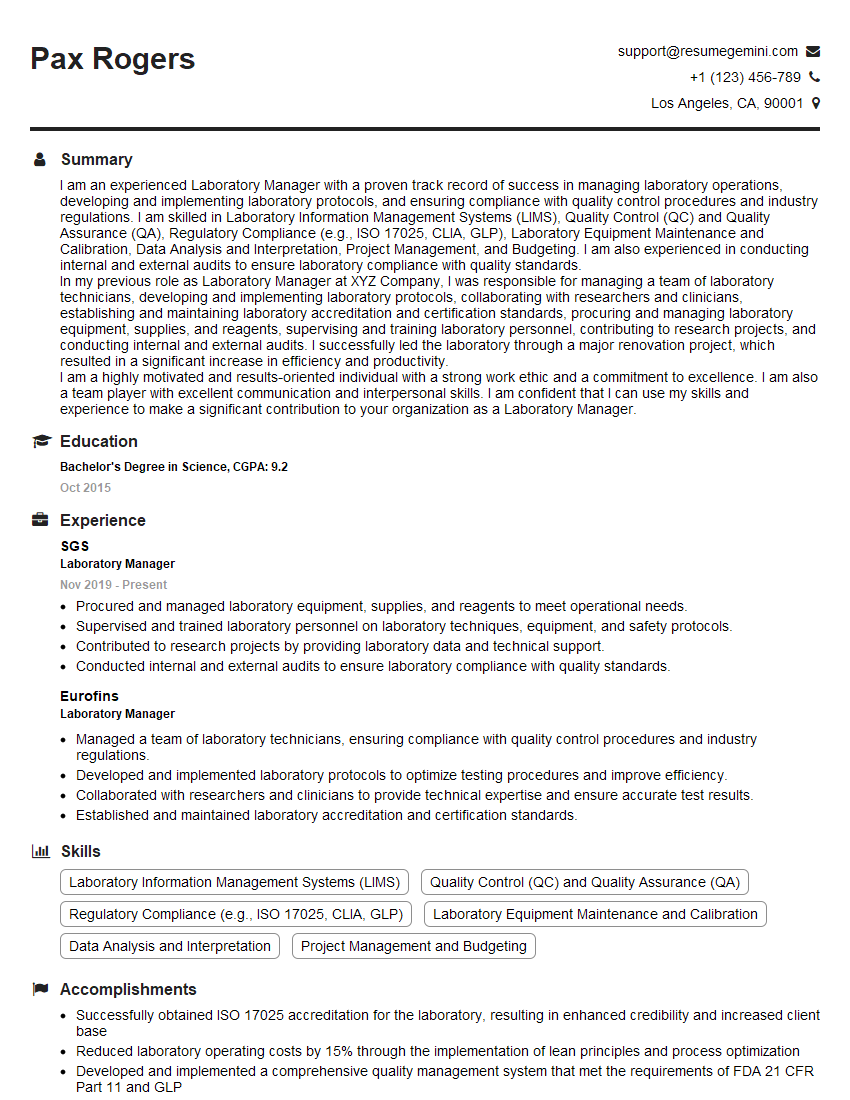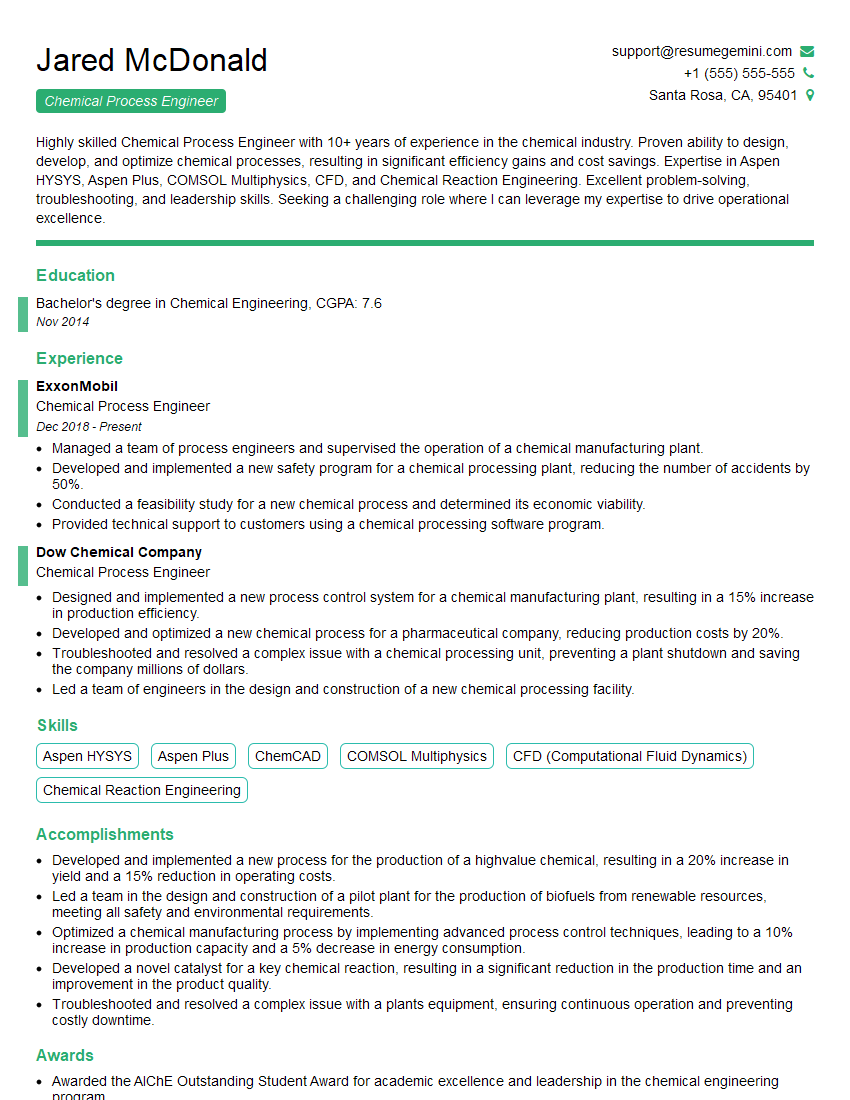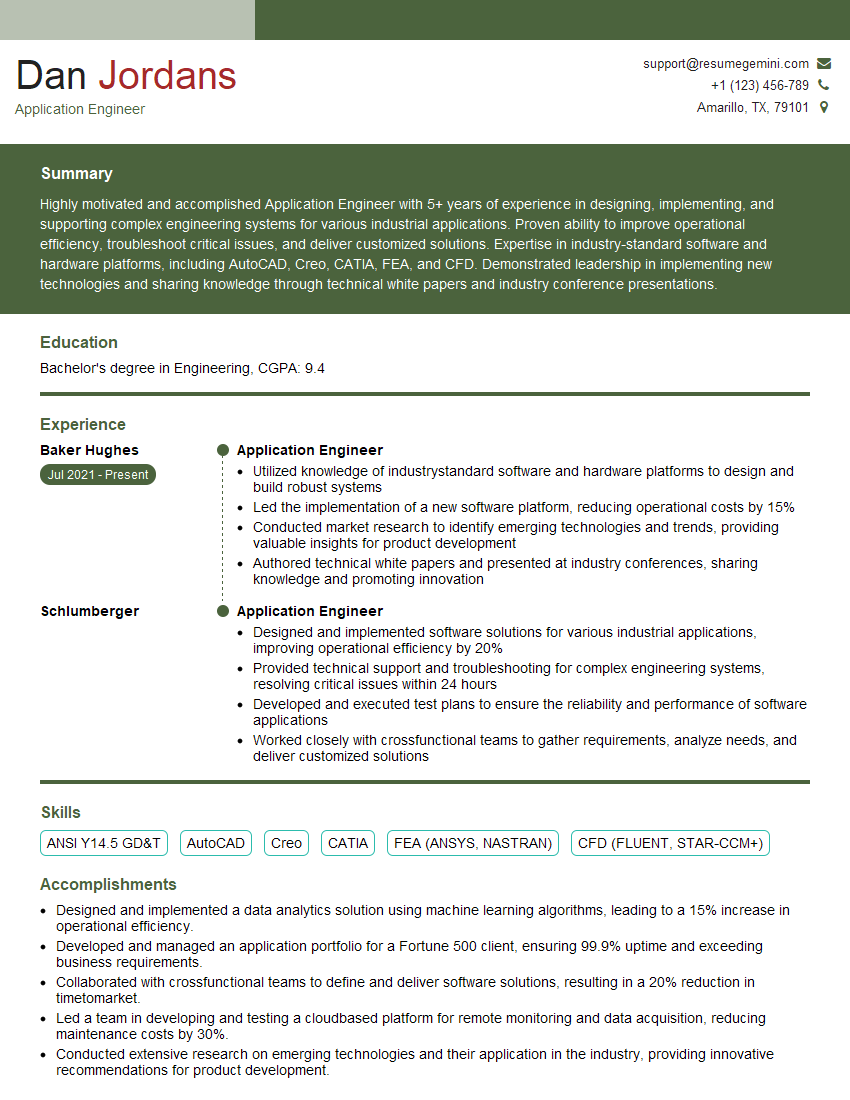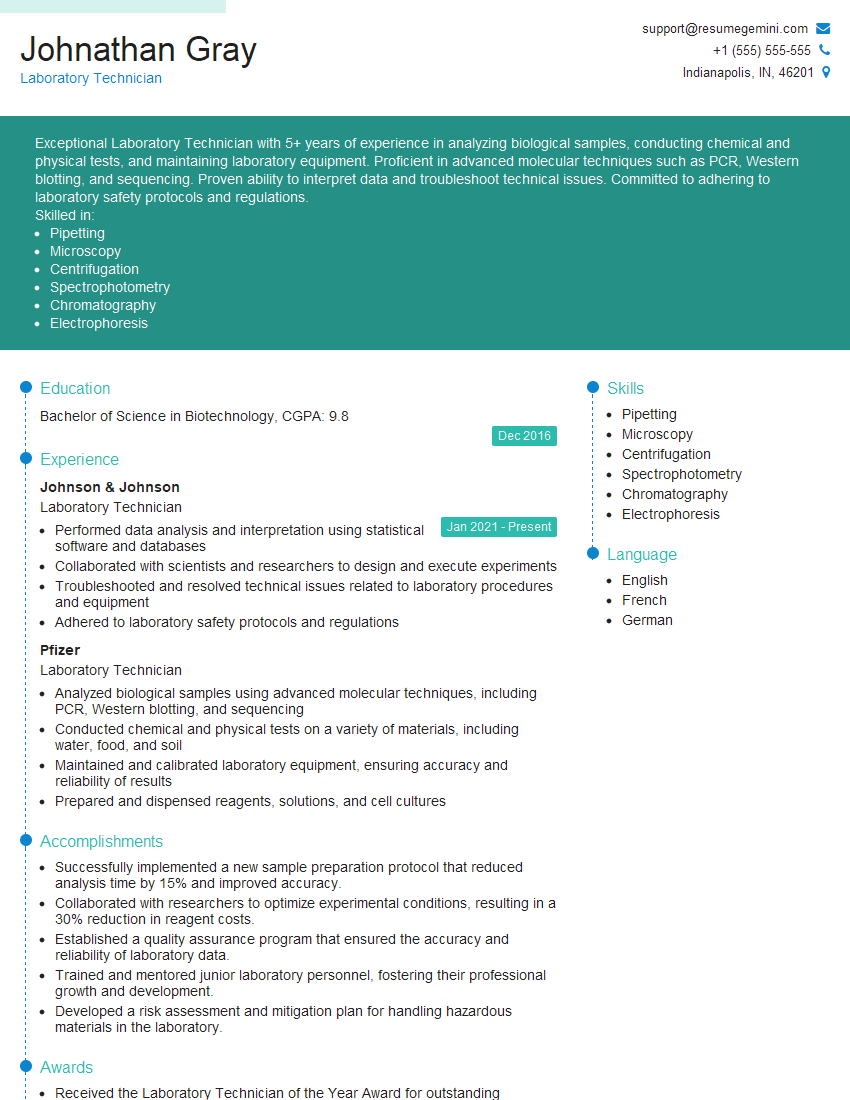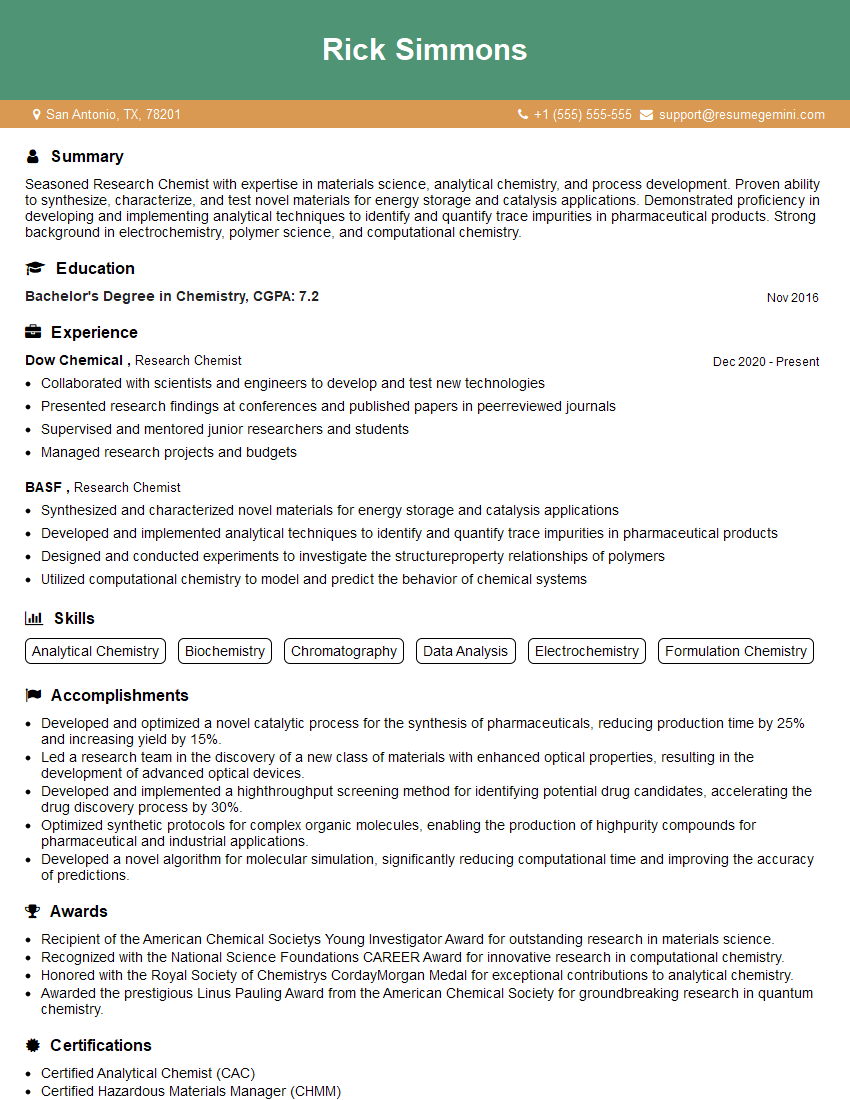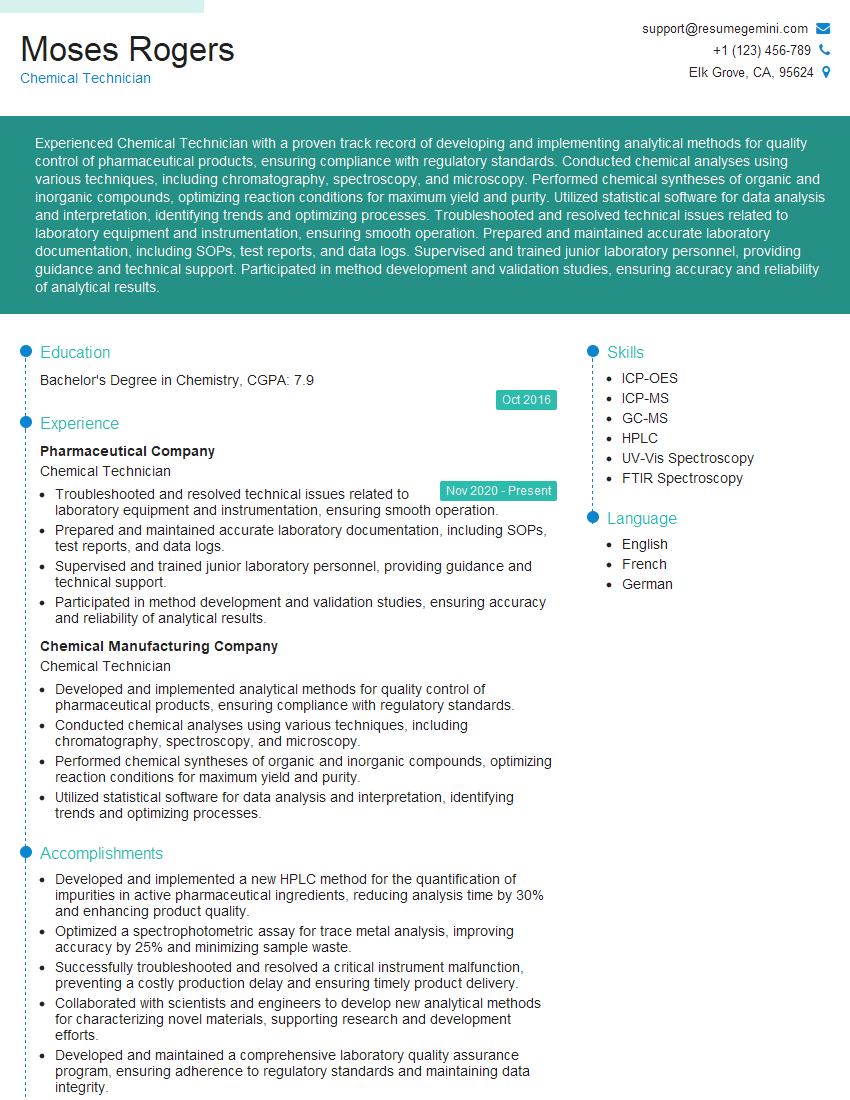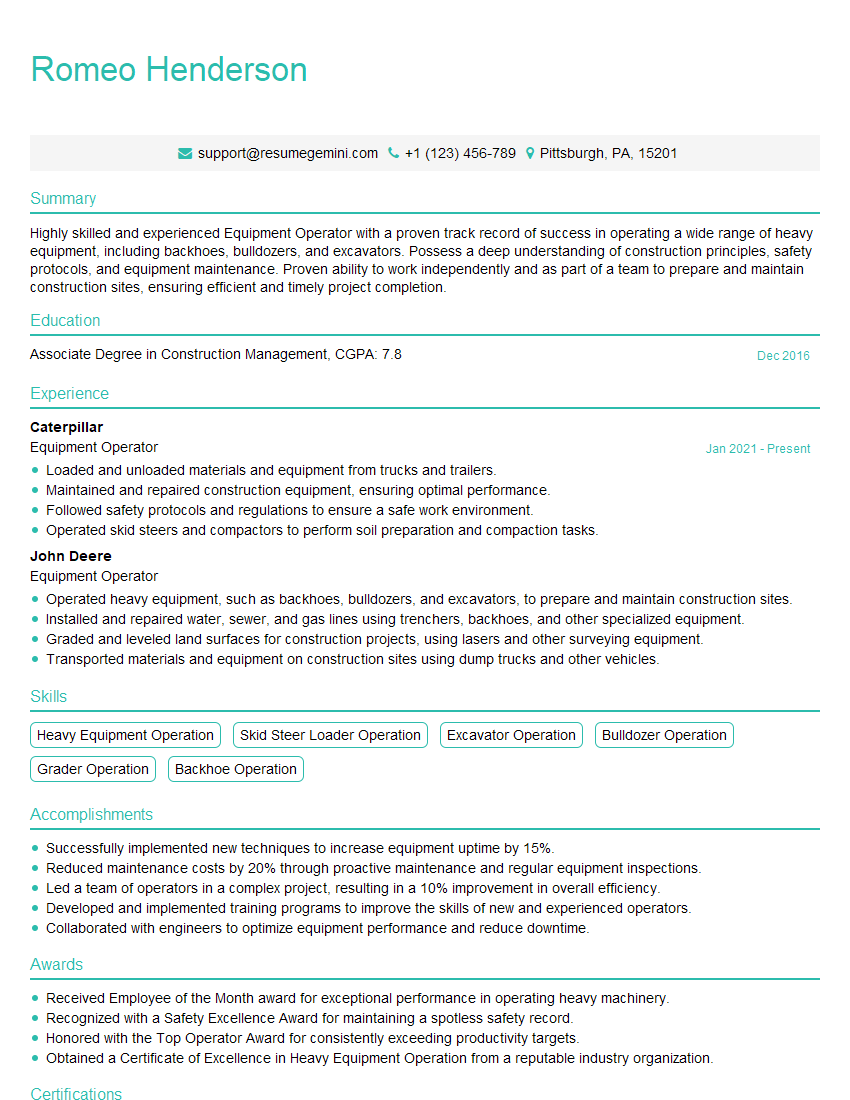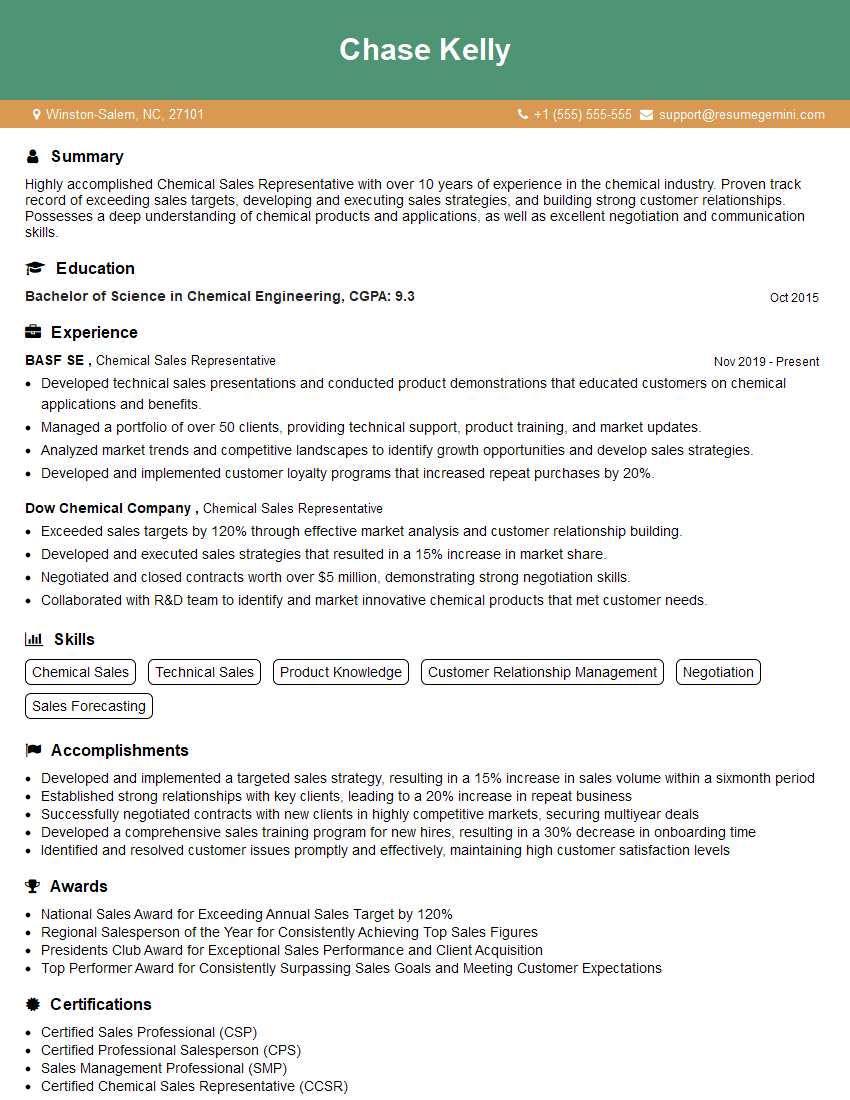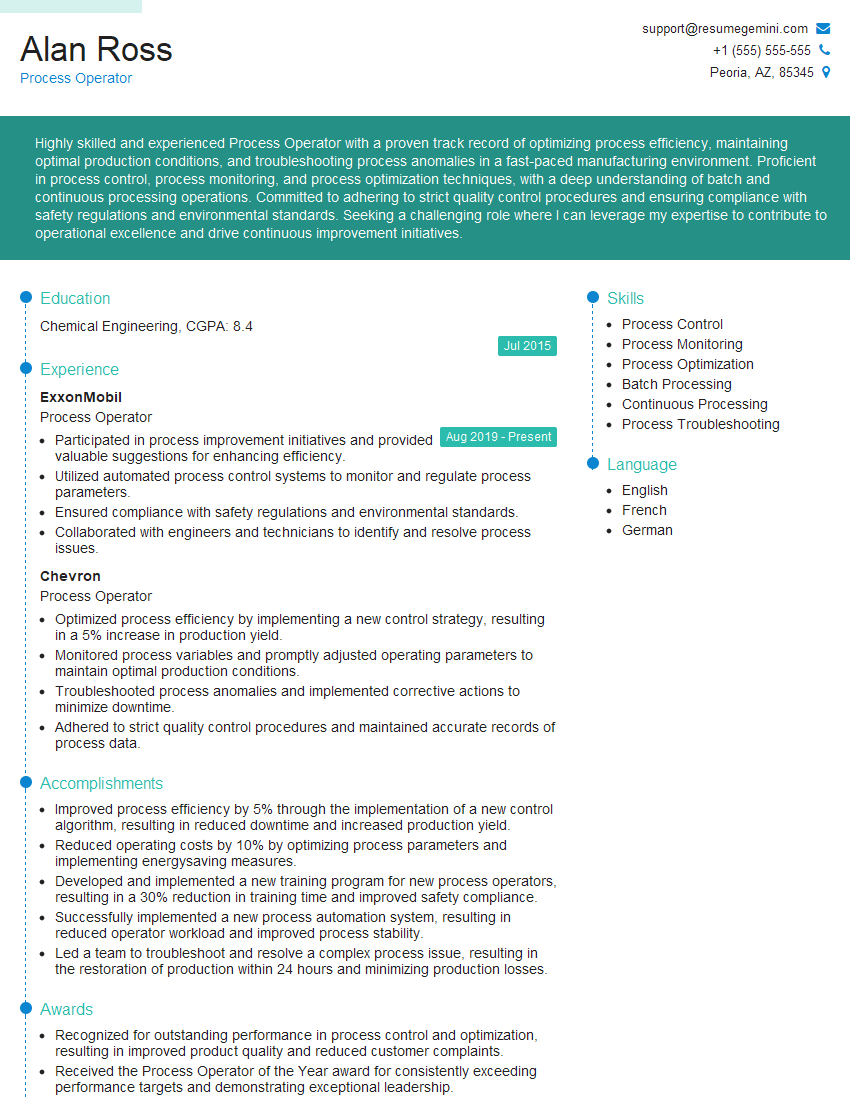Feeling uncertain about what to expect in your upcoming interview? We’ve got you covered! This blog highlights the most important Chemicals and Equipment Use interview questions and provides actionable advice to help you stand out as the ideal candidate. Let’s pave the way for your success.
Questions Asked in Chemicals and Equipment Use Interview
Q 1. Describe your experience with HPLC and GC techniques.
HPLC (High-Performance Liquid Chromatography) and GC (Gas Chromatography) are two powerful analytical techniques I’ve extensively used for separating and quantifying components in complex mixtures. HPLC is ideal for separating non-volatile or thermally labile compounds using a liquid mobile phase and a stationary phase packed in a column. I’ve used it extensively for analyzing pharmaceuticals, identifying impurities, and quantifying active pharmaceutical ingredients. For example, I used reversed-phase HPLC to analyze the purity of a newly synthesized drug candidate, successfully identifying and quantifying trace impurities that would impact its efficacy. GC, on the other hand, is suited for separating volatile and thermally stable compounds using a gaseous mobile phase. My experience with GC includes analyzing volatile organic compounds (VOCs) in environmental samples and characterizing the composition of essential oils. A memorable project involved using GC-MS (Gas Chromatography-Mass Spectrometry) to identify the specific aroma compounds in a rare type of lavender, enabling a more precise quality control for the producer. In both techniques, data analysis using software like ChemStation or Empower is crucial to extract meaningful results and ensure quality control.
Q 2. Explain the principles of chemical reaction kinetics.
Chemical reaction kinetics studies the rates of chemical reactions and the factors that influence them. It’s all about understanding how fast reactants transform into products. The rate is often expressed as a change in concentration over time. Several factors affect reaction rates, including:
- Concentration of reactants: Higher concentration generally leads to faster rates as there’s a greater chance of reactant molecules colliding and reacting.
- Temperature: Increasing temperature increases the kinetic energy of molecules, leading to more frequent and energetic collisions, and thus a faster rate.
- Surface area: For heterogeneous reactions (those involving reactants in different phases), a larger surface area increases the contact between reactants, increasing the rate.
- Presence of a catalyst: Catalysts provide an alternative reaction pathway with lower activation energy, speeding up the reaction without being consumed themselves.
A fundamental concept is the rate law, which mathematically describes the relationship between reaction rate and reactant concentrations. For example, a simple second-order reaction (where the rate depends on the square of the concentration of a single reactant) might have a rate law of: rate = k[A]², where k is the rate constant.
Understanding reaction kinetics is crucial in designing efficient chemical processes, optimizing reaction conditions, and predicting reaction outcomes. For instance, optimizing the temperature and pressure in an industrial reactor to maximize product yield while minimizing byproducts relies on a thorough understanding of the reaction kinetics involved.
Q 3. How would you troubleshoot a malfunctioning centrifuge?
Troubleshooting a malfunctioning centrifuge requires a systematic approach. First, I’d start by identifying the specific problem. Is the centrifuge not spinning at all? Is it vibrating excessively? Is it producing inaccurate results? Then, I would follow these steps:
- Safety First: Always ensure the centrifuge is switched off and unplugged before any inspection or maintenance.
- Visual Inspection: Check for any obvious signs of damage, such as loose components, cracked rotors, or damaged power cords.
- Rotor Balance: Ensure that the tubes are properly balanced across the rotor. Uneven distribution of weight is a common cause of vibration and malfunction. I always use a balance for accurate weight matching.
- Check the Lid Lock: Make sure the lid is securely closed and the locking mechanism is functioning correctly. The centrifuge often won’t start if the lid isn’t properly latched.
- Inspect the Drive System: If the problem persists, examine the centrifuge’s drive system for any mechanical issues (though this usually requires professional servicing).
- Check the Power Supply: Verify that the centrifuge is properly plugged in and the outlet is functioning.
- Consult Documentation: Refer to the centrifuge’s operation manual for troubleshooting guidance specific to the model.
- Seek Professional Help: If the issue is complex or beyond simple troubleshooting, contact qualified service personnel.
For example, once, while working with a high-speed ultracentrifuge, I discovered that the rotor was slightly out of balance, causing excessive vibration. Re-balancing the tubes completely resolved the issue.
Q 4. What safety precautions are essential when handling hazardous chemicals?
Safety is paramount when handling hazardous chemicals. The precautions depend on the specific chemical’s hazards (e.g., flammability, toxicity, corrosiveness), but some general guidelines include:
- Personal Protective Equipment (PPE): Always wear appropriate PPE, such as lab coats, safety glasses or goggles, gloves (chosen based on chemical compatibility), and closed-toe shoes.
- Proper Ventilation: Work in a well-ventilated area or use a fume hood, especially when dealing with volatile or toxic chemicals. Never work with hazardous chemicals in enclosed spaces.
- Safe Handling Procedures: Follow proper techniques for handling and transferring chemicals. Avoid direct contact, and use appropriate tools (e.g., pipettes, funnels) to avoid spills.
- Chemical Hygiene Plan (CHP): Adhere to the facility’s CHP, which outlines specific safety procedures and protocols for handling hazardous chemicals in the workplace.
- Spill Response: Know the location and proper use of spill kits and emergency response procedures. In case of a spill, follow the established protocols to clean and neutralize the spill, minimizing exposure and environmental impact.
- Proper Disposal: Dispose of hazardous waste according to regulations and using designated containers. Never mix incompatible chemicals.
- Safety Data Sheets (SDS): Always consult the SDS for each chemical before handling it to understand its potential hazards and necessary safety precautions.
Ignoring these precautions can have serious consequences, ranging from minor skin irritation to severe health problems or even fatalities. A strong safety culture and diligent adherence to safety protocols are crucial in any chemical handling environment.
Q 5. Describe your experience with different types of reactors.
My experience encompasses various reactor types, each suited for specific reaction conditions and scales. I’ve worked with:
- Batch Reactors: These are simple, versatile reactors where reactants are added, allowed to react, and then discharged. They are ideal for small-scale reactions or experiments where precise control over reaction time and temperature is needed.
- Continuous Stirred-Tank Reactors (CSTRs): In these reactors, reactants are continuously fed and products are continuously withdrawn, resulting in a steady-state operation. CSTRs are suitable for large-scale industrial processes requiring high throughput and steady product quality.
- Plug Flow Reactors (PFRs): In PFRs, the fluid flows through a tube or pipe, with minimal mixing. They are often used for reactions where precise control over residence time is crucial.
- Fluidized Bed Reactors: These reactors utilize a fluidized bed of solid catalyst particles, allowing for efficient heat and mass transfer. They are commonly used in catalytic processes, particularly in the petroleum and petrochemical industries.
The choice of reactor type depends on factors such as reaction kinetics, desired scale of operation, heat and mass transfer requirements, and the nature of the reactants and products. For instance, I designed a CSTR for a continuous production of a specific polymer, ensuring a consistent product flow with excellent control over the reaction temperature and pressure.
Q 6. How do you ensure the accuracy and precision of your measurements?
Ensuring accuracy and precision in measurements is critical for reliable results. My approach involves several steps:
- Calibration and Maintenance: Regularly calibrate instruments against traceable standards to ensure accuracy. Proper maintenance, including cleaning and preventative checks, is also vital.
- Appropriate Instrumentation: Select the appropriate instruments based on the required level of accuracy and precision. For example, an analytical balance is used for precise mass measurements in contrast to a top-loading balance.
- Proper Technique: Follow proper techniques for using instruments and equipment. Accurate pipetting, for instance, is fundamental for reliable results in many chemical analyses.
- Multiple Measurements: Perform multiple measurements and calculate the average to reduce the impact of random errors and enhance precision.
- Control Experiments: Use control experiments to assess the impact of potential sources of error and improve the overall accuracy of the measurements.
- Data Analysis: Apply appropriate statistical methods to analyze the data and assess its accuracy and precision, identifying and mitigating outliers.
For example, when determining the concentration of a solution, I would perform multiple titrations and calculate the average to ensure reliability. Using proper techniques like careful buret readings and appropriate indicator selection further enhances accuracy.
Q 7. Explain the difference between accuracy and precision.
Accuracy and precision are related but distinct concepts in measurement. Accuracy refers to how close a measurement is to the true or accepted value. Precision, on the other hand, refers to how close repeated measurements are to each other.
Think of it like shooting arrows at a target:
- High accuracy, high precision: All arrows are clustered tightly together near the bullseye.
- High accuracy, low precision: Arrows are scattered widely, but the average location is near the bullseye.
- Low accuracy, high precision: Arrows are tightly clustered, but far from the bullseye.
- Low accuracy, low precision: Arrows are scattered randomly across the target.
In a chemical analysis, high accuracy means getting a result close to the actual concentration, while high precision indicates that repeated measurements give similar results. Both accuracy and precision are important for reliable results, though sometimes one might be prioritized over the other depending on the specific application.
Q 8. Describe your experience with calibration and validation of equipment.
Calibration and validation are crucial for ensuring the accuracy and reliability of equipment used in chemical processes. Calibration involves adjusting equipment to match a known standard, while validation confirms that the equipment consistently performs as intended. My experience encompasses both aspects, working with a variety of instruments including analytical balances, pH meters, spectrophotometers, and HPLC systems.
For example, when calibrating an analytical balance, I follow a standardized procedure using certified weights. This involves weighing several weights of known mass, comparing the readings to their certified values, and adjusting the balance if necessary. Validation, on the other hand, often involves running samples of known concentrations through the system to verify accuracy and precision. I’ve documented this process extensively, following Good Documentation Practices (GDP), and generating reports demonstrating compliance with regulatory standards. I’ve also been involved in the validation of new equipment, which requires a comprehensive approach including IQ (Installation Qualification), OQ (Operational Qualification), and PQ (Performance Qualification).
- IQ: Verifying the equipment is correctly installed and configured.
- OQ: Demonstrating the equipment operates within its specifications.
- PQ: Confirming the equipment consistently produces accurate and reliable results under normal operating conditions.
Q 9. How do you handle chemical spills and waste disposal?
Handling chemical spills and waste disposal requires a systematic approach prioritizing safety and environmental protection. My experience includes responding to various spills, from small accidental leaks to larger incidents involving hazardous materials. The first step is always to ensure the safety of personnel – evacuating the area and contacting emergency services if necessary. Then, I assess the situation, identifying the spilled chemical and its potential hazards using the Safety Data Sheet (SDS). This guides the appropriate cleanup procedure, selecting personal protective equipment (PPE) like gloves, goggles, and respirators.
Different chemicals require different cleanup methods. Some might be neutralized with a specific substance, while others require careful absorption with inert materials like spill pillows or vermiculite. Waste is segregated according to its chemical composition and disposed of responsibly according to local regulations and waste disposal contracts. All incidents are documented thoroughly, including the type of chemical, quantity spilled, methods used for cleanup, and any corrective actions taken to prevent future occurrences.
For example, I once responded to a spill involving concentrated sulfuric acid. After securing the area and notifying the appropriate personnel, we carefully neutralized the spill with a sodium bicarbonate solution, followed by thorough cleanup and neutralization solution disposal in accordance with environmental regulations. The event was documented with photographs and a detailed report detailing the entire incident and corrective actions implemented to prevent recurrence.
Q 10. What is your experience with process control systems (e.g., PLC, DCS)?
My experience with process control systems (PCS) like PLCs (Programmable Logic Controllers) and DCSs (Distributed Control Systems) extends to monitoring, troubleshooting, and basic programming. I’ve worked with PCS systems in various chemical manufacturing settings to monitor and control process parameters like temperature, pressure, and flow rate. I understand the importance of these systems in maintaining consistent product quality and ensuring safe operations.
I’m proficient in interpreting process flow diagrams (P&IDs) and using HMI (Human-Machine Interface) software to monitor and adjust process parameters. While I haven’t directly programmed complex PLC or DCS logic, I can troubleshoot basic issues, identify potential problems through data analysis, and collaborate with automation engineers to resolve more complex problems. For example, I’ve used HMI screens to monitor reactor temperatures and make minor adjustments to maintain optimal reaction conditions. I’ve also helped identify and resolve process upsets by analyzing data from the DCS, pinpointing the cause, and suggesting corrective actions.
Q 11. Describe your experience with preventative maintenance of equipment.
Preventative maintenance (PM) is essential for extending the lifespan of equipment, improving safety, and ensuring consistent operational efficiency. My experience involves executing scheduled PM tasks based on manufacturer recommendations and established protocols. This often includes lubrication, inspection, cleaning, and minor repairs to prevent equipment failure. I maintain detailed records of all PM activities, ensuring compliance with regulatory requirements and company standards.
For instance, in a previous role, I was responsible for the preventative maintenance of centrifugal pumps used in chemical transfer. This involved regular inspections of bearings, seals, and motor components, along with lubrication and cleaning as per the manufacturer’s specifications. Any identified issues, even minor ones, were immediately documented and addressed to prevent potentially costly repairs or downtime in the future. This proactive approach helped maintain high production uptime and minimize the risk of unplanned equipment failures. Following a documented PM schedule was key to ensuring this success.
Q 12. How do you interpret SDS (Safety Data Sheets)?
Safety Data Sheets (SDSs) are crucial documents providing comprehensive information about the hazards associated with a chemical substance. I’m proficient in interpreting SDSs to identify potential risks, appropriate handling procedures, and emergency response actions. Each SDS follows a standardized format, making it relatively easy to locate specific information.
I focus on key sections including the identification of hazards (chemical name, CAS number, health hazards, physical hazards), handling and storage (personal protective equipment requirements, storage conditions), first-aid measures, and accidental release measures (spill cleanup procedures, containment methods). The SDS provides the information needed to safely handle, store, and dispose of chemicals, ensuring worker safety and environmental protection. For example, before working with a new chemical, I always consult its SDS to understand its health hazards, flammability, and reactivity, allowing me to implement appropriate safety measures and PPE.
Q 13. Explain your understanding of Good Manufacturing Practices (GMP).
Good Manufacturing Practices (GMP) are a set of guidelines ensuring the consistent production of high-quality products that meet safety and purity standards. My understanding of GMP encompasses various aspects, including personnel training, equipment calibration and validation, raw material handling, production processes, and quality control. The core principle is to prevent contamination and ensure consistent product quality.
GMP principles cover areas such as facility hygiene, equipment sanitation, documentation control (batch records, SOPs), and deviation handling. Adhering to GMP minimizes the risk of product defects, recalls, and potential harm to consumers. I’ve worked in environments with strict GMP compliance, where careful documentation and thorough procedures are essential. For example, I’ve been involved in writing and reviewing Standard Operating Procedures (SOPs) for chemical processes, ensuring all steps adhere to GMP standards and are clear and concise. Proper training of personnel is key, to ensure GMP compliance in every aspect of the process.
Q 14. How do you ensure the quality of raw materials and finished products?
Ensuring the quality of raw materials and finished products involves a multi-step approach, combining incoming inspection, process monitoring, and final product testing. Raw materials are inspected upon receipt to ensure they meet predetermined specifications, often involving physical and chemical testing. This might include checking for purity, particle size, and other critical quality attributes.
During the manufacturing process, in-process controls are employed to monitor critical parameters and ensure consistency. Finally, finished products undergo rigorous testing to verify they meet all required specifications and quality standards, often involving analytical techniques like chromatography and spectroscopy. This information is compiled and documented, forming a comprehensive quality control record for each batch. Deviation investigation is also important – if a deviation from specified parameters occurs during production, a root-cause analysis is performed, corrective actions are implemented, and the event is thoroughly documented.
For example, in quality control of a pharmaceutical product, raw materials are tested for purity and identity before use. During manufacturing, critical process parameters (temperature, pressure, time) are carefully monitored and recorded. The final product undergoes rigorous testing, including potency, purity, and sterility assays, ensuring that it meets all quality standards before release.
Q 15. What is your experience with statistical process control (SPC)?
Statistical Process Control (SPC) is a powerful collection of tools used to monitor and control the variability in a process. It’s essentially about preventing problems rather than reacting to them. Think of it like a preventative health checkup for your manufacturing process – regular monitoring to identify potential issues before they lead to major defects or failures.
My experience with SPC includes extensive use of control charts, such as Shewhart charts (X-bar and R charts, for example), and CUSUM charts. I’ve applied these to monitor parameters like reaction yield, purity of synthesized compounds, and the consistency of equipment performance. For instance, in a pharmaceutical synthesis, I used X-bar and R charts to track the reaction temperature and yield over multiple batches. Identifying an upward trend in the R chart (indicating increased variability) allowed us to proactively investigate the cause, which turned out to be a faulty heating element. Early detection via SPC saved us from producing a whole batch of substandard product.
Beyond control charts, I’m familiar with capability analysis (Cp, Cpk) for assessing process capability relative to specifications and process behavior charts to study how various process inputs might affect the output. I’m also proficient in using statistical software packages like Minitab and JMP to analyze data and generate reports.
Career Expert Tips:
- Ace those interviews! Prepare effectively by reviewing the Top 50 Most Common Interview Questions on ResumeGemini.
- Navigate your job search with confidence! Explore a wide range of Career Tips on ResumeGemini. Learn about common challenges and recommendations to overcome them.
- Craft the perfect resume! Master the Art of Resume Writing with ResumeGemini’s guide. Showcase your unique qualifications and achievements effectively.
- Don’t miss out on holiday savings! Build your dream resume with ResumeGemini’s ATS optimized templates.
Q 16. Describe a time you had to troubleshoot a complex equipment problem.
During the synthesis of a novel organometallic compound, our high-pressure reactor unexpectedly shut down mid-reaction. The initial diagnostic tests yielded no clear cause. This was a complex issue because the reactor is a highly specialized piece of equipment with numerous interconnected safety mechanisms. The pressure inside was still high, preventing immediate access.
My troubleshooting strategy involved a systematic approach:
- Safety First: Prioritizing safety, we followed established emergency protocols to safely depressurize the reactor.
- Data Analysis: I meticulously reviewed the reactor’s operational logs and sensor data leading up to the shutdown. We identified a minor, seemingly insignificant, fluctuation in the internal temperature sensor readings just before the shutdown.
- Component Testing: After depressurization, we systematically tested each component individually, paying close attention to the temperature sensor and its associated circuitry. We used calibration equipment to verify the accuracy of all sensors.
- Root Cause Identification: Ultimately, we discovered a slight calibration drift in the temperature sensor, triggering a premature safety shutdown.
- Corrective Action: The sensor was recalibrated, and the control software was updated with tighter tolerances to prevent future false alarms.
This experience underscored the importance of meticulous record-keeping and the necessity of a systematic, step-by-step approach to troubleshooting complex equipment malfunctions, with emphasis on safety protocols.
Q 17. How do you maintain a clean and organized laboratory workspace?
Maintaining a clean and organized lab workspace is paramount for safety, efficiency, and accuracy. Think of it as a surgeon preparing for an operation – a sterile and organized environment is crucial.
My approach involves a multi-pronged strategy:
- Daily Cleaning: Cleaning up spills and disposing of waste immediately prevents accumulation and contamination. This includes wiping down benches, cleaning glassware, and ensuring proper disposal of chemicals.
- Organized Storage: Chemicals are stored according to their hazard class, with clear labeling and inventory management. Equipment is stored in designated locations, making it easily accessible and preventing damage.
- Preventive Maintenance: Regularly scheduled checks on instruments and equipment prevent malfunctions and maintain accuracy, such as verifying the calibration of balances and analytical instruments.
- 5S Methodology: I utilize the 5S methodology (Sort, Set in Order, Shine, Standardize, Sustain) to organize the workspace for efficiency and to create a visual system for maintaining cleanliness.
A well-organized lab is not just aesthetically pleasing; it’s a critical factor in preventing accidents and ensuring reliable experimental results.
Q 18. Explain your understanding of different chemical hazards (e.g., flammability, toxicity).
Understanding chemical hazards is fundamental to safe laboratory practices. It’s about recognizing the potential dangers of the substances we handle and taking appropriate precautions.
Flammability: This refers to the ease with which a substance ignites and burns. Highly flammable chemicals, like ethers and many organic solvents, require special handling, including the use of flame-resistant clothing, proper ventilation, and storage in designated flammable material cabinets.
Toxicity: This describes the harmful effects a substance can have on living organisms. Toxicity can manifest in various ways, from acute poisoning (immediate effects) to chronic toxicity (long-term health problems). Examples include cyanide (acute) and many heavy metals (chronic). Appropriate personal protective equipment (PPE), like gloves and eye protection, and strict adherence to safe handling procedures are essential.
Other Hazards: Beyond flammability and toxicity, other significant hazards include reactivity (chemicals that react violently with each other or with water), corrosivity (substances that damage living tissue), and carcinogenicity (cancer-causing agents). Safety Data Sheets (SDS) provide comprehensive information about the specific hazards of each chemical and the necessary safety measures.
My approach to handling chemicals always begins with a thorough review of the SDS. I never underestimate the importance of understanding and adhering to all safety precautions.
Q 19. Describe your experience with different types of analytical instruments.
My experience encompasses a wide range of analytical instruments, including:
- Spectroscopy: I’m proficient in using UV-Vis, IR, NMR, and Mass Spectrometry for structural elucidation and quantitative analysis of various compounds. For example, using NMR spectroscopy to determine the purity of a synthesized drug molecule or using mass spectrometry for identifying unknown impurities.
- Chromatography: I have extensive experience with HPLC (High-Performance Liquid Chromatography) and GC (Gas Chromatography) for separating and quantifying mixtures of compounds. This has been used extensively in drug analysis or environmental monitoring.
- Titration: Acid-base titrations, redox titrations, and other titrimetric techniques are routine for quantitative analysis.
- Electrochemical techniques: I have worked with potentiometry and voltammetry for measuring electrochemical properties.
I am also comfortable with the maintenance, calibration, and troubleshooting of these instruments. For example, I have trouble-shot HPLC systems by identifying and replacing faulty pump seals or clogged columns, resulting in the restoration of instrument efficiency.
Q 20. What is your experience with data analysis and interpretation?
Data analysis and interpretation are integral to my work. It’s not just about collecting data; it’s about extracting meaningful insights to draw accurate conclusions and make informed decisions.
My approach involves several steps:
- Data Cleaning and Preprocessing: Identifying and correcting errors, outliers, and inconsistencies in the raw data.
- Descriptive Statistics: Calculating measures of central tendency (mean, median, mode) and variability (standard deviation, variance) to summarize data.
- Inferential Statistics: Using statistical tests (t-tests, ANOVA, regression analysis) to draw inferences about the population from the sample data.
- Data Visualization: Creating graphs and charts (scatter plots, histograms, box plots) to visually represent data and identify patterns.
- Interpretation and Reporting: Drawing conclusions based on the statistical analysis and communicating findings in a clear and concise manner using reports and presentations.
For example, in a recent project, I used regression analysis to model the relationship between reaction temperature and yield, enabling optimization of the reaction conditions to maximize product output. Effective data analysis is essential for making critical decisions and driving process improvements.
Q 21. How do you ensure compliance with environmental regulations?
Ensuring compliance with environmental regulations is a critical responsibility. It’s about minimizing our environmental footprint and protecting public health. This involves careful planning and meticulous record-keeping.
My approach includes:
- Proper Waste Disposal: All chemical waste is classified and disposed of according to local, state, and federal regulations. This includes using proper containers, labeling appropriately, and working with licensed waste disposal companies.
- Spill Response Plans: Maintaining a comprehensive plan for handling chemical spills, including procedures for containment, cleanup, and reporting.
- Emission Control: Following appropriate procedures to minimize the release of hazardous chemicals into the environment. This often includes using appropriate ventilation systems and monitoring equipment to check emissions.
- Record Keeping: Maintaining detailed records of all chemical use, waste disposal, and emission monitoring data. These records are vital for compliance audits and demonstrating adherence to regulations.
- Staying Updated: Staying informed about current environmental regulations and best practices through professional development and participation in relevant training programs.
Environmental compliance isn’t just about avoiding penalties; it’s about being a responsible member of the community and ensuring the long-term health of our planet.
Q 22. Explain your understanding of process optimization and improvement.
Process optimization and improvement is about systematically enhancing the efficiency, productivity, and safety of a chemical process. It involves analyzing existing procedures, identifying bottlenecks or inefficiencies, and implementing changes to achieve desired improvements. Think of it like fine-tuning a car engine – you want to maximize performance while minimizing fuel consumption and emissions.
- Step 1: Define Objectives: Clearly state what needs improvement. Are we aiming for higher yield, reduced waste, lower energy consumption, or improved product quality?
- Step 2: Process Mapping: Visually represent the process flow, identifying all steps and their interactions. This often involves flowcharts or process diagrams.
- Step 3: Data Analysis: Collect and analyze relevant data (yield, temperature, pressure, reaction time, etc.) to pinpoint areas for improvement. Statistical process control (SPC) charts can be incredibly helpful here.
- Step 4: Identify Bottlenecks: Determine which steps are limiting overall efficiency. This often requires a detailed understanding of reaction kinetics, mass transfer, and heat transfer.
- Step 5: Implement Changes: Based on the analysis, implement changes such as modifying reaction parameters (temperature, pressure, catalyst concentration), improving mixing, or optimizing separation techniques.
- Step 6: Monitor and Evaluate: Continuously monitor the process after implementing changes to ensure they achieve the desired results and to identify any unintended consequences.
For example, in a pharmaceutical manufacturing process, I once optimized a crystallization step by adjusting the cooling rate and seeding strategy, leading to a 15% increase in product yield and a significant reduction in impurities.
Q 23. Describe your experience with different types of pumps and valves.
My experience encompasses a wide range of pumps and valves, crucial components in any chemical process. Choosing the right pump and valve depends heavily on the fluid’s properties (viscosity, corrosiveness, temperature), flow rate, and pressure requirements.
- Pumps: I’ve worked with centrifugal pumps (ideal for high flow rates and low viscosity liquids), positive displacement pumps (for high viscosity or shear-sensitive fluids, like peristaltic or diaphragm pumps), and even specialized pumps for handling slurries or corrosive chemicals.
- Valves: My experience includes various valve types, such as gate valves (on-off control), globe valves (throttling control), ball valves (quick on-off control), check valves (prevent backflow), and diaphragm valves (ideal for corrosive fluids). Safety relief valves are also crucial, ensuring pressure does not exceed safe limits.
For instance, in a pilot plant, we used a peristaltic pump to handle a highly viscous, shear-sensitive polymer solution. The gentle pumping action prevented degradation of the polymer, which would have negatively impacted the final product’s quality. Selecting the appropriate valve type – in that case, a diaphragm valve – was equally critical to prevent corrosion.
Q 24. How do you identify and mitigate potential safety hazards?
Safety is paramount in chemical handling and processing. Identifying and mitigating potential hazards requires a proactive and systematic approach. This involves a thorough understanding of the chemicals involved, the equipment used, and the process itself.
- Hazard Identification: This involves using techniques like Hazard and Operability studies (HAZOP), Failure Mode and Effects Analysis (FMEA), and reviewing Safety Data Sheets (SDS) for all chemicals. This step identifies potential hazards such as fires, explosions, chemical releases, and health risks.
- Risk Assessment: After identifying hazards, we assess the likelihood and severity of each hazard to determine the overall risk. This uses a risk matrix to prioritize hazards.
- Mitigation Strategies: Based on the risk assessment, we implement appropriate control measures, including:
- Engineering controls (e.g., installing ventilation systems, using explosion-proof equipment)
- Administrative controls (e.g., implementing lockout/tagout procedures, providing safety training)
- Personal protective equipment (PPE) (e.g., providing respirators, gloves, safety glasses)
- Emergency Response Planning: Developing and regularly practicing emergency response plans ensures a coordinated response to any incident.
For example, in a project involving highly flammable solvents, we implemented a system of inert gas blanketing to prevent fires. We also instituted rigorous lockout/tagout procedures during maintenance to prevent accidental activation of equipment. Regular safety drills reinforced the procedures and increased operator confidence.
Q 25. What is your understanding of chemical engineering principles?
Chemical engineering principles form the foundation of my work. They encompass a broad range of concepts, including:
- Thermodynamics: Understanding energy balances and equilibrium is crucial for designing efficient processes and predicting reaction behavior. For example, calculating heat transfer rates in a reactor.
- Fluid Mechanics: This is essential for designing and operating pumps, pipes, and reactors, considering pressure drop, flow rates, and mixing efficiency.
- Heat and Mass Transfer: Understanding how heat and mass transfer occur is critical for designing efficient heat exchangers and separation processes.
- Reaction Kinetics and Reactor Design: This involves understanding reaction rates, selecting appropriate reactors, and optimizing reaction conditions for maximum yield and selectivity.
- Process Control: Implementing control systems to maintain process parameters within safe and efficient operating ranges.
- Separation Processes: Designing and optimizing techniques such as distillation, extraction, and filtration for purifying products.
These principles are interconnected and applied in a synergistic manner during process design, optimization, and troubleshooting. For example, when designing a distillation column, thermodynamics helps to predict the vapor-liquid equilibrium, while fluid mechanics determines the optimal column diameter and tray spacing.
Q 26. Describe your experience with different types of separation techniques.
My experience with separation techniques is extensive. The choice of technique depends on the physical and chemical properties of the components to be separated.
- Distillation: Used to separate components based on their boiling points. I’ve worked with both batch and continuous distillation columns, optimizing parameters like reflux ratio and number of stages to maximize separation efficiency.
- Extraction: This separates components based on their relative solubility in different solvents. I have experience with liquid-liquid extraction and solid-liquid extraction, including techniques like Soxhlet extraction.
- Filtration: Used for separating solids from liquids, employing techniques like pressure filtration, vacuum filtration, and membrane filtration. The choice depends on the particle size, concentration, and desired clarity of the filtrate.
- Chromatography: A powerful technique for separating complex mixtures based on the differential distribution of components between a stationary and a mobile phase. I have experience with various types, including gas chromatography (GC) and high-performance liquid chromatography (HPLC).
- Crystallization: Separating a solid solute from a liquid solution by inducing crystallization. I’ve worked on optimizing parameters such as supersaturation, cooling rate, and seeding to achieve high purity and desired crystal size.
For example, in a project involving the purification of a pharmaceutical intermediate, we used a combination of liquid-liquid extraction followed by crystallization to achieve the desired purity and yield. The selection of the extraction solvent was critical to maximize the separation efficiency.
Q 27. How do you ensure the accuracy and reliability of your experimental results?
Ensuring accuracy and reliability of experimental results is crucial for successful chemical engineering. This involves a multifaceted approach, starting from meticulous experimental design and extending to rigorous data analysis and reporting.
- Proper Calibration and Maintenance: All equipment used, including analytical instruments (e.g., GC, HPLC, spectrometers), should be regularly calibrated and maintained to ensure accuracy and precision.
- Control of Experimental Variables: Carefully control all parameters (temperature, pressure, flow rate, etc.) during experiments to minimize variability and uncertainty. Repeating experiments several times is essential to assess reproducibility.
- Error Analysis: Evaluate all potential sources of error (random and systematic) to estimate the uncertainty in measurements. This often involves statistical analysis techniques.
- Data Recording and Management: Maintain detailed and organized laboratory notebooks to document experimental procedures, data, and observations. Use data management systems to store and analyze data efficiently.
- Data Analysis and Interpretation: Employ appropriate statistical methods to analyze experimental data, such as calculating means, standard deviations, and performing regression analysis. Critically evaluate results and identify outliers or inconsistencies.
- Documentation and Reporting: Clearly document all aspects of the experimental work, including methods, results, analysis, and conclusions. Use appropriate figures, tables, and graphs to present findings effectively.
For example, in a kinetics study, we conducted multiple experiments at varying temperatures and reactant concentrations. We used regression analysis to determine the rate constant and its associated uncertainty. This rigorous approach ensured the reliability and accuracy of the reported rate law.
Key Topics to Learn for Chemicals and Equipment Use Interview
- Chemical Safety and Handling: Understanding SDS sheets, proper PPE selection and use, safe storage and disposal procedures, and emergency response protocols. Practical application: Describe a scenario where you had to handle a hazardous chemical and explain the safety measures you took.
- Equipment Operation and Maintenance: Familiarity with various laboratory and industrial equipment (e.g., centrifuges, autoclaves, reactors, pumps). Practical application: Explain the routine maintenance procedures for a specific piece of equipment and troubleshoot a common malfunction.
- Process Optimization and Control: Understanding process parameters, data analysis techniques, and optimization strategies for chemical processes. Practical application: Describe a situation where you improved a chemical process or equipment efficiency.
- Quality Control and Assurance: Implementing quality control measures, interpreting analytical data, and ensuring compliance with relevant regulations (e.g., GMP, GLP). Practical application: Explain how you would ensure the quality and consistency of a chemical product.
- Troubleshooting and Problem-Solving: Identifying and resolving issues related to chemical processes and equipment malfunctions. Practical application: Describe a time you encountered a problem with equipment or a process and how you solved it.
- Regulatory Compliance: Knowledge of relevant health, safety, and environmental regulations concerning chemical handling and equipment use. Practical application: Discuss your understanding of relevant safety regulations and how you ensure compliance.
Next Steps
Mastering Chemicals and Equipment Use is crucial for career advancement in many scientific and industrial fields. A strong understanding of these topics demonstrates competence, responsibility, and a commitment to safety. To significantly improve your job prospects, focus on crafting an ATS-friendly resume that highlights your skills and experience. ResumeGemini is a trusted resource that can help you build a professional and impactful resume. We provide examples of resumes tailored to Chemicals and Equipment Use to guide you in showcasing your qualifications effectively. This will give you a distinct advantage in the job market.
Explore more articles
Users Rating of Our Blogs
Share Your Experience
We value your feedback! Please rate our content and share your thoughts (optional).
What Readers Say About Our Blog
good
